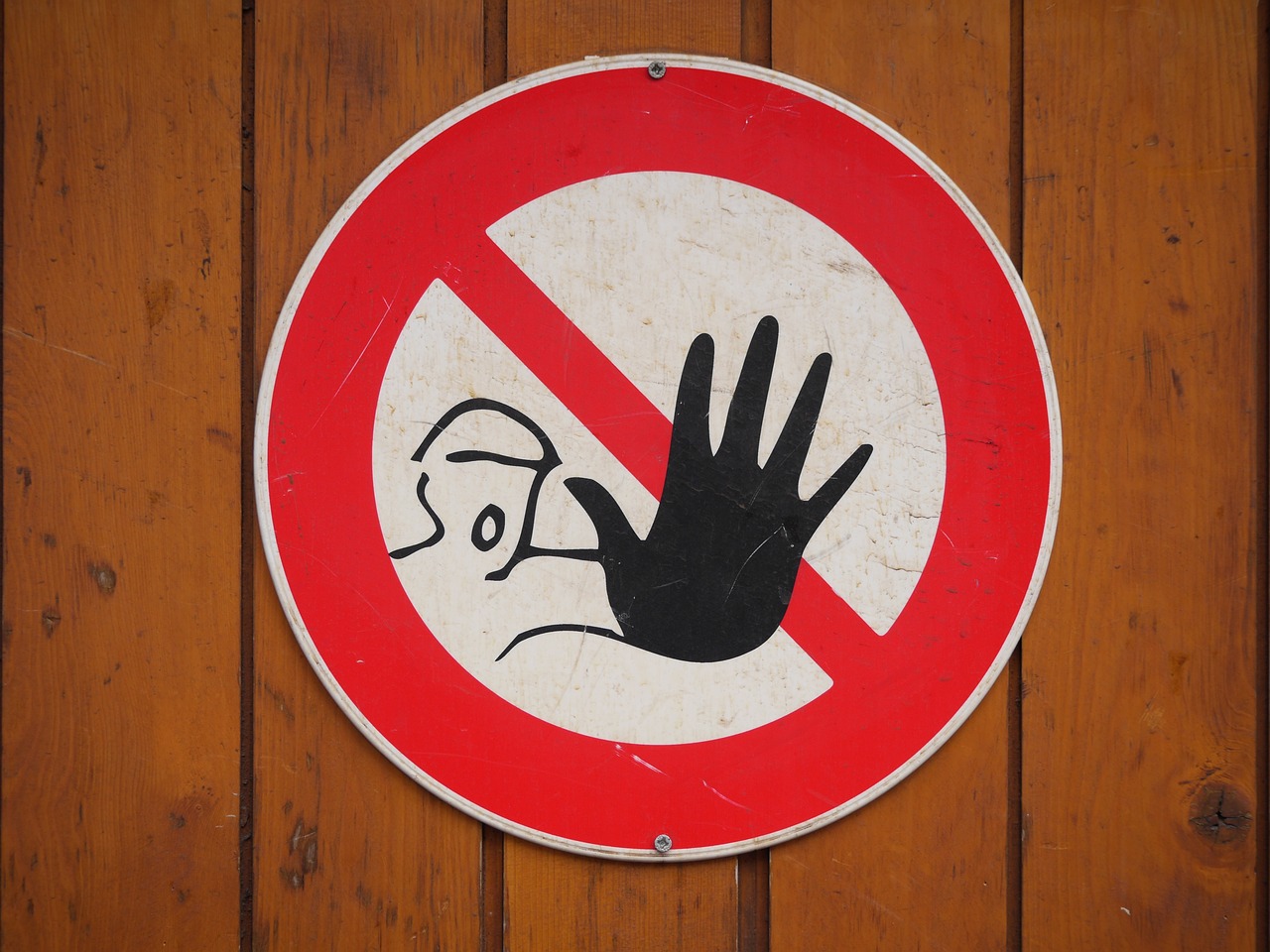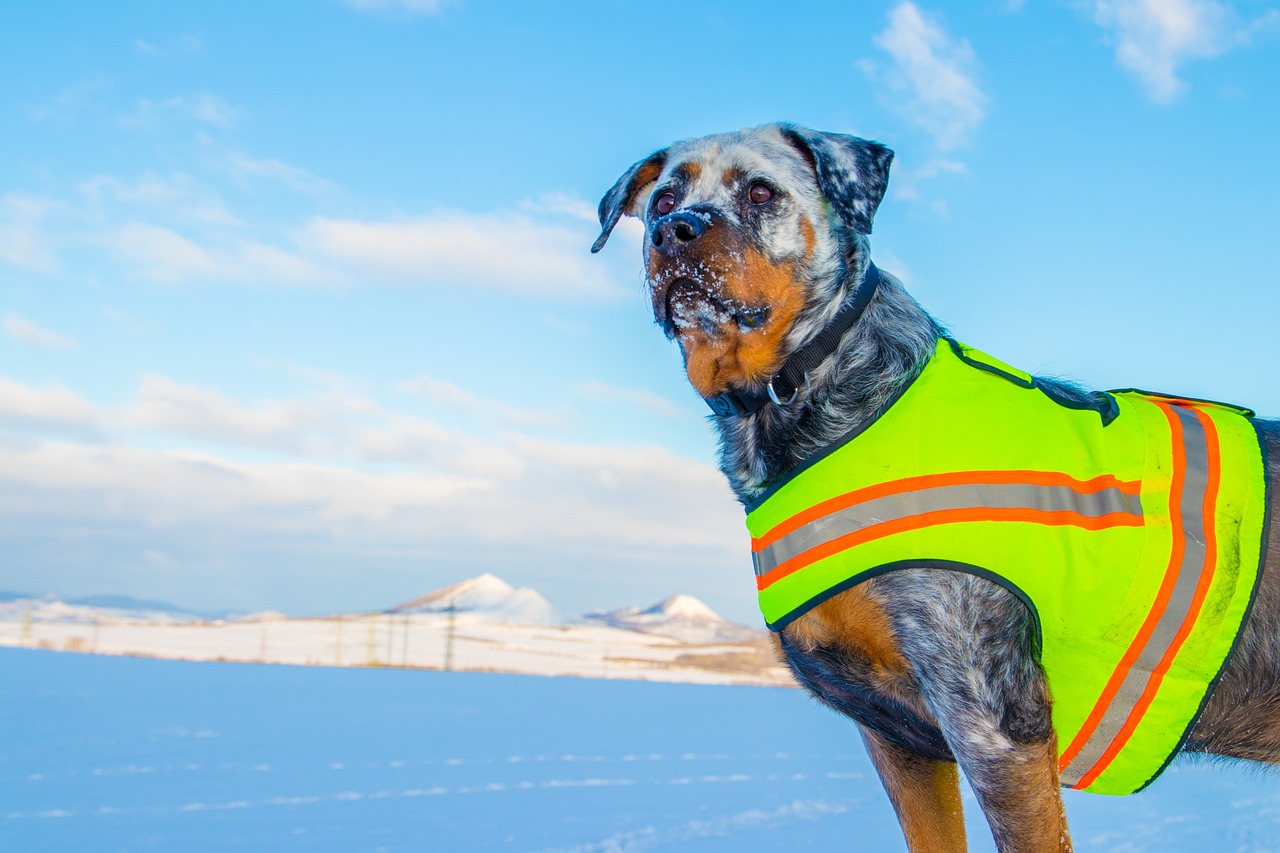How to Protect Your Pet from Wildlife Attacks
As a pet owner, there's nothing more heart-wrenching than the thought of your beloved furry friend facing danger from wildlife. The great outdoors can be a beautiful playground, but it also harbors potential threats that can turn a peaceful day into a nightmare. In this article, we will explore effective strategies to safeguard your pets from potential wildlife threats, emphasizing prevention, awareness, and safety measures that all pet owners should consider. After all, a little preparation can go a long way in ensuring your pet's safety!
Recognizing the types of wildlife that pose risks to pets is crucial. Different regions are home to various animals, each with unique behaviors that can lead to dangerous interactions with domesticated animals. For instance, coyotes, raccoons, and even hawks can pose serious threats, especially to smaller pets. Understanding their habits—like hunting at dawn or dusk—can help you anticipate potential dangers and take appropriate actions to keep your pet safe. It's essential to be aware of your surroundings and the wildlife native to your area.
Designing a secure outdoor space for your pet can significantly reduce risks. A well-thought-out outdoor environment acts as the first line of defense against wildlife encounters. This involves not only the physical barriers but also the strategic planning of safe zones where your pets can roam freely without the fear of unexpected wildlife intrusions. Consider the layout of your yard, the types of plants you have, and the overall fencing options available to you.
Choosing the right fencing is vital for pet safety. Not all fences are created equal, and certain types are more effective at keeping wildlife out than others. For example, wooden fences can be easily scaled by determined animals, while chain-link fences might not provide the necessary height. Here are some options to consider:
- Wooden Fences: Sturdy but may require additional height.
- Chain-link Fences: Good visibility but can be climbed.
- Vinyl Fences: Durable and aesthetically pleasing.
- Stock Fencing: Effective for larger properties.
Ultimately, the height and materials of your fence should be chosen based on the types of wildlife common in your area.
Utilizing natural barriers like dense shrubs and thorny plants can help create an additional layer of protection. Strategically planting these barriers not only beautifies your yard but also deters wildlife from entering. Consider using plants like hawthorn or barberry, which are not only beautiful but also act as a natural deterrent to intruders. Additionally, maintaining a well-trimmed landscape ensures that your yard remains a less inviting environment for wildlife.
Electric fences can be an effective deterrent against wildlife. They work by delivering a mild shock to any animal that attempts to cross the boundary, teaching them to stay away. When installing an electric fence, it's essential to ensure that it is set up correctly and is safe for your pets. Always consult with a professional to discuss the best options for your property and to understand the safety protocols involved.
Always supervising pets outdoors is essential for their safety. Even in a secure environment, unforeseen circumstances can arise. Leashing your pets during walks not only keeps them close to you but also allows you to maintain control in case of a wildlife encounter. It’s like having a safety net—keeping your pet within reach can prevent them from wandering into danger.
Training your pet to respond to commands can enhance their safety. A well-trained pet is less likely to engage with wildlife or wander off into areas where they could be at risk. Effective training techniques, such as positive reinforcement and consistent practice, can be invaluable. Remember, a little patience goes a long way when it comes to training!
Teaching your pet to return on command can prevent dangerous encounters. This is especially important in areas where wildlife is prevalent. Start by practicing in a controlled environment and gradually introduce distractions. Use treats and praise to reinforce positive behavior, creating a strong association between coming when called and receiving rewards.
Desensitizing pets to wildlife sounds and sights can reduce anxiety and improve their response. Gradually exposing your pet to recorded sounds of wildlife or visual stimuli can help them remain calm in the presence of real animals. This technique can be particularly useful for pets that may be skittish or overly curious.
Being aware of wildlife presence is crucial for pet safety. Look for signs such as tracks, droppings, or even the sounds of animals nearby. If you suspect that wildlife may be in your area, take precautions to keep your pet indoors or supervised outside. Knowing when to be alert can make all the difference in keeping your furry friend safe.
Preparing for wildlife encounters involves having a plan. In the unfortunate event that your pet is threatened or attacked, knowing what to do can help you act quickly and effectively. This includes having a first aid kit ready and familiarizing yourself with basic first aid techniques.
Knowing basic first aid can save your pet's life. If your pet suffers injuries from a wildlife encounter, the first step is to assess the situation. Control any bleeding, keep your pet calm, and seek veterinary assistance immediately. Here are some essential first aid steps for common injuries:
- Apply pressure to stop bleeding.
- Clean wounds with saline solution.
- Keep your pet warm and calm.
Seeking immediate veterinary care after an attack is critical. Your vet will assess the injuries and provide necessary treatment. Be prepared to discuss what happened, as this information can help in diagnosing and treating any potential infections or complications. Follow-up care is also important to ensure your pet heals properly.
Q: What should I do if I see wildlife near my home?
A: Keep your pets indoors, and do not approach the wildlife. Contact local animal control if necessary.
Q: How can I train my pet to stay safe outdoors?
A: Consistent training, including recall commands and desensitization techniques, can enhance your pet's safety.
Q: What types of fencing are best for keeping wildlife out?
A: The best fencing options include tall wooden or vinyl fences, and electric fences can be effective as well.

Understanding Wildlife Threats
When it comes to keeping our beloved pets safe, understanding the wildlife threats that lurk in our surroundings is a crucial first step. Many pet owners may not realize that various types of wildlife can pose risks to their furry friends. From curious raccoons to aggressive coyotes, these animals can interact with our pets in unpredictable ways. It's essential to recognize that wild animals are not just harmless creatures; they can sometimes be driven by instinct or hunger, leading to dangerous encounters.
One of the most common threats comes from predatory animals. For instance, coyotes are known to roam urban areas, often seeking easy prey. They are opportunistic hunters and can pose a significant risk, especially to smaller pets. Additionally, birds of prey, such as hawks and owls, can also target small animals. It's vital to understand the behaviors of these predators to better protect our pets.
Moreover, not all wildlife interactions are predatory. Some animals, like raccoons and skunks, can transmit diseases such as rabies, which can be fatal to pets. These animals are often attracted to pet food left outside or unsecured trash cans, creating an open invitation for them to come closer to your home. It's important to be aware of their habits and the signs of their presence, such as:
- Tracks in the mud or snow
- Scat or droppings
- Damaged garden plants or overturned trash cans
Another wildlife threat that pet owners should consider is the presence of snakes in certain areas. Many snakes are non-venomous, but some can deliver a painful bite or even be lethal to pets. Understanding the types of snakes in your region and their behaviors can help you take preventive measures, such as avoiding tall grass or rocky areas where snakes might hide.
In addition to recognizing these threats, it's also vital to be aware of seasonal changes that may affect wildlife behavior. For example, during the spring and summer months, many animals are more active, especially as they seek food for their young. This increased activity can lead to more encounters with pets, making it essential for pet owners to be vigilant during these times.
In summary, understanding the various wildlife threats that can impact your pets is not just about awareness; it's about being proactive. By recognizing the types of animals that may pose a risk and understanding their behaviors, you can take effective steps to protect your furry companions from potential harm.

Creating a Safe Outdoor Environment
When it comes to keeping our furry friends safe, the outdoor environment plays a crucial role. Just like we wouldn’t let a child play in a busy street, we must ensure that our pets have a secure area to roam and explore. Creating a safe outdoor space is not just about letting them enjoy the fresh air; it’s about protecting them from potential wildlife threats that could turn a peaceful day into a nightmare. So, how do we go about designing this safe haven for our beloved pets?
First and foremost, fencing is your best friend. A sturdy fence acts as a physical barrier against wildlife intrusions. But not all fences are created equal! You’ll want to consider the height, material, and design of the fence. For instance, a wooden fence might look great but could easily be climbed by determined raccoons or deer. On the other hand, a tall chain-link fence provides visibility while keeping larger animals out. Ideally, you should aim for a fence that is at least six feet high, as this height can deter most wildlife from jumping over.
Choosing the right fencing is vital for pet safety. Here are some effective options:
- Wooden Fences: A classic choice, but ensure it's tall enough and has no gaps.
- Chain-Link Fences: Great visibility and can be reinforced with barbed wire on top.
- PVC Fences: Durable and low maintenance, but check for climbability.
In addition to traditional fencing, consider natural barriers. Dense shrubs and thorny plants can serve as an additional layer of protection. Not only do they look beautiful, but they also create a natural deterrent for wildlife. For instance, planting a row of thorny bushes like blackberries or hawthorn can keep out curious animals while offering your pet a cozy spot to explore. Strategically placing these natural barriers around the perimeter of your yard can make a significant difference.
Utilizing natural barriers like dense shrubs and thorny plants can help create an additional layer of protection. When planning your landscape, think about planting:
- Holly bushes
- Roses with thorns
- Barberry shrubs
These plants not only enhance the beauty of your yard but also serve as an effective deterrent to wildlife, making it less likely for them to wander into your pet’s territory.
If you’re looking for an extra layer of security, consider installing an electric fence. These fences can be highly effective at deterring wildlife while allowing your pets to enjoy the freedom of an open yard. Electric fences work by delivering a mild shock to any animal that tries to cross the boundary, teaching them to stay away. However, it’s essential to ensure that your pets are trained to understand the boundaries and that the system is installed correctly to prevent accidental harm.
Remember, while creating a safe outdoor environment is crucial, it’s equally important to supervise your pets when they are outside. Even the best fencing can’t replace the watchful eye of a loving owner. So, keep an eye on your furry friends and enjoy those sunny days together!
Fencing Solutions
When it comes to keeping your furry friends safe from wildlife, are one of the most effective measures you can implement. A well-constructed fence not only serves as a physical barrier but also provides peace of mind for pet owners. However, choosing the right type of fence can be a bit overwhelming, given the variety of options available. It’s essential to consider factors such as height, material, and design to ensure that your fence effectively keeps unwanted wildlife at bay.
First and foremost, the height of your fence plays a crucial role in its effectiveness. For example, a fence that is at least 6 feet tall is generally recommended to deter larger animals like deer or coyotes. If you live in an area where raccoons or foxes are common, a fence of 4 to 5 feet may suffice, but always consider the potential for animals to jump or climb. Additionally, the type of material used for the fence can significantly impact its durability and effectiveness. Here are a few popular materials:
| Material | Advantages | Disadvantages |
|---|---|---|
| Wood | Natural look, customizable height | Can rot, requires maintenance |
| Vinyl | Durable, low maintenance | Higher initial cost |
| Chain Link | Cost-effective, easy to install | Less privacy, can be climbed |
| Electric | Highly effective deterrent | Requires power, can be costly |
Another important aspect to consider is the design of the fence. A solid panel fence can be excellent for preventing wildlife from seeing into your yard, which can deter curious animals. However, if you prefer a more open design, you might want to look into fences with slats or lattice work that still provide visibility while keeping pets secure. Additionally, it’s wise to extend the fence underground by at least a foot to prevent burrowing animals from digging their way in. This is particularly relevant in areas where critters like raccoons or rabbits are prevalent.
Don’t forget about the gates! Ensure that any gates are as sturdy as the fence itself and have secure latches that are difficult for animals to manipulate. A simple latch can be a weak point in your defense against wildlife, so investing in a high-quality locking mechanism can be a game changer.
Ultimately, the right fencing solution will depend on your specific situation, including the types of wildlife in your area, the size of your yard, and your pet's behavior. By taking the time to assess these factors, you can create a safe haven for your pets that minimizes the risk of wildlife encounters.
Natural Barriers
When it comes to safeguarding your beloved pets from potential wildlife threats, one of the most effective methods is to utilize around your property. These barriers not only enhance the aesthetic appeal of your outdoor space but also provide a practical solution to keep unwanted wildlife at bay. Imagine your garden transformed into a lush sanctuary, teeming with vibrant plants that serve a dual purpose: beautifying your home while acting as a protective shield for your furry friends.
Strategically planting dense shrubs, thorny bushes, and tall grasses can create a formidable obstacle for wildlife. For instance, consider using plants like barberry or holly, which are not only visually appealing but also deter animals with their sharp thorns. Additionally, incorporating a variety of heights and textures in your landscaping can confuse and disorient potential intruders, making it less likely for them to approach your pets. Think of it as creating a natural fortress that blends seamlessly with your landscape.
Moreover, the placement of these natural barriers is crucial. Position them along the perimeter of your yard or garden to create a buffer zone. This can be particularly effective in areas where wildlife is known to roam. For example, if you live near wooded areas or fields, planting a thick row of shrubs can act as a first line of defense against curious deer, raccoons, or even coyotes. Not only does this provide a physical barrier, but it also serves as a psychological one. Wildlife is less likely to venture into areas that appear dense and impenetrable.
In addition to shrubs, consider incorporating ground cover plants that can fill in gaps and create an additional layer of protection. Vines can also be trained to grow up fences or trellises, adding height and complexity to your barriers. The more challenging you make it for wildlife to access your yard, the safer your pets will be. Remember, the goal is to create an environment that is inviting for your pets but unwelcoming for wildlife.
Ultimately, investing time and effort into creating natural barriers is a proactive step every pet owner should consider. Not only does it enhance your property’s beauty, but it also provides peace of mind knowing that you’re doing everything possible to protect your furry companions. So, roll up your sleeves, get your hands dirty, and start planting those defenses today!
- What types of plants are best for natural barriers? Dense shrubs like barberry, holly, and thorny plants are excellent choices as they deter wildlife effectively.
- How tall should natural barriers be? Ideally, natural barriers should be at least 3-4 feet tall to discourage most wildlife from jumping over them.
- Can I combine natural barriers with fencing? Absolutely! Combining natural barriers with traditional fencing creates a more secure environment for your pets.
- How do I maintain these natural barriers? Regular trimming and care will ensure that your plants remain healthy and effective as barriers.
Electric Fences
When it comes to keeping your pets safe from potential wildlife encounters, can serve as an effective deterrent. These fences work by delivering a mild shock to animals that attempt to cross the boundary, which can be an excellent way to keep curious critters at bay. Imagine a protective barrier that not only marks your pet's territory but also teaches any intruders to think twice before entering. However, before you rush into installation, it's essential to understand how these fences operate, their benefits, and the precautions you should take to ensure your pet's safety.
Electric fences typically consist of a series of wires that carry a low-voltage current. When an animal touches the wire, it receives a brief shock that is enough to discourage it from trying to breach the fence again. This method is particularly effective for dogs and cats, who may be tempted to chase after wildlife. The shock is not harmful; rather, it acts as a training tool for your pets as well. However, it is crucial to install these systems correctly to prevent any accidental harm to your pets.
Here are some key considerations when thinking about electric fences:
- Type of Fence: There are various types of electric fencing available, including underground and above-ground options. Underground fences, often referred to as invisible fences, require a wire to be buried around your property, creating a defined boundary without visible barriers. Above-ground fences are more traditional and can be seen easily.
- Height and Visibility: While electric fences are designed to deter animals, it’s essential to ensure that they are tall enough to keep out larger wildlife, such as deer or coyotes. Additionally, visible markers can help your pets understand the boundaries.
- Training: Proper training is vital. You need to teach your pet what the fence means. This can involve using flags or markers during the initial training phase, allowing your pet to associate the area with the electric fence.
- Maintenance: Regular checks on the functionality of the electric fence are necessary. Over time, wear and tear can lead to malfunctions, which could compromise your pet's safety.
Moreover, while electric fences can be an effective solution, they should not be the sole measure for pet safety. It’s essential to combine them with other strategies, such as supervision and training. Remember, the goal is not just to create a barrier but to foster a safe environment where your furry friends can roam freely without the fear of wildlife encounters.
In conclusion, electric fences can be a valuable addition to your pet safety toolkit. They offer a unique way to establish boundaries while also safeguarding your pets from potential wildlife threats. Just ensure that you take the necessary precautions and provide adequate training to your pets, making their outdoor adventures both enjoyable and safe.
Supervision and Leashing
When it comes to keeping your furry friends safe from wildlife, supervision and leashing are two of the most effective strategies you can employ. Imagine this: you’re at a park, the sun is shining, and your dog is frolicking around, tail wagging with joy. It’s a beautiful scene, but lurking nearby could be a wild animal, ready to disrupt the peace. This is why constant supervision is crucial. Pets, especially dogs and cats, are naturally curious creatures. They might not understand the dangers that lurk just beyond the fence or in the bushes. By keeping a watchful eye on them, you can intervene before they get too close to potential threats.
Leashing your pet is another vital aspect of ensuring their safety outdoors. Not only does it give you control over their movements, but it also prevents them from straying into areas where wildlife might be present. While many pet owners enjoy the idea of letting their pets roam freely, it can lead to dangerous situations. A leash acts as a barrier, keeping your pet close to you and away from wildlife encounters. Think of it as a safety net; it allows your pet to explore while still being protected from unexpected wildlife interactions.
Moreover, it’s not just about keeping pets on a leash; it’s about using the right kind of leash for the environment. For instance, if you’re hiking in a wooded area where wildlife sightings are common, a sturdy, longer leash might give your dog the freedom to explore while still being under your control. However, in more urban settings, a shorter leash can help keep your pet close and safe from sudden wildlife encounters.
In addition to leashing, consider these tips for effective supervision:
- Always stay within sight of your pet; if you can’t see them, you can’t protect them.
- Choose safe spots for outdoor play that are known to be free from wildlife.
- Be aware of your surroundings; if you notice signs of wildlife, it’s best to keep your pet leashed and close.
In conclusion, while it may seem like a hassle at times, are essential practices for any pet owner who wants to keep their four-legged friends safe from the unpredictable nature of wildlife. By being proactive and attentive, you can ensure that your pet enjoys their outdoor adventures without the risk of encountering danger.
Q: How can I train my pet to stay close during outdoor activities?
A: Training your pet to respond to commands is key. Start in a controlled environment and gradually introduce distractions. Use treats and positive reinforcement to encourage them to stay close.
Q: What should I do if I see wildlife while walking my pet?
A: If you spot wildlife, calmly call your pet back to you and keep them on a short leash. Avoid approaching the wildlife, as it can be unpredictable and may feel threatened.
Q: Are there specific leashes recommended for different pet sizes?
A: Yes! For small pets, lightweight leashes are ideal, while larger dogs may require more durable, thicker leashes to ensure control and safety.
Q: How can I create a safe outdoor space for my pet?
A: Consider using secure fencing, natural barriers, and designated play areas that are away from wildlife habitats. Regularly inspect your outdoor space for any signs of wildlife.

Training Your Pet
Training your pet is not just about teaching them tricks; it’s a vital component of ensuring their safety, especially when it comes to wildlife encounters. Imagine your furry friend darting off into the bushes after a squirrel, completely unaware of the potential dangers lurking nearby. By investing time in training, you can significantly reduce the risks associated with such scenarios. One of the most effective strategies is to focus on obedience commands that will keep your pet close and alert them to potential threats.
One of the key commands to master is the recall command, which is essentially teaching your pet to return to you on cue. This is crucial for their safety, especially in environments where wildlife is present. To achieve this, start in a controlled setting, like your backyard, and gradually increase distractions. Use treats or their favorite toy as a reward when they respond correctly. Over time, this will reinforce their behavior and make them more likely to return when you call, even in the face of distractions.
Another important aspect of training is desensitization. This involves gradually exposing your pet to the sights and sounds of wildlife in a controlled manner. Start by playing recordings of wildlife noises at a low volume while engaging your pet in play or providing treats. As they become more comfortable, you can increase the volume. This technique helps your pet associate these sounds with positive experiences, reducing anxiety during real encounters. Remember, the goal is to create a calm and confident pet that won’t panic at the sight of a raccoon or deer.
In addition to these techniques, consistency is key. Establish a regular training routine and make it a fun experience for both you and your pet. The more they enjoy training, the more likely they are to respond positively to commands. Incorporating playtime into training sessions can make learning feel less like a chore and more like a game. For example, after a successful recall, engage in a quick game of fetch. This not only reinforces the behavior but also strengthens your bond.
Lastly, don’t forget that training is an ongoing process. Regularly practicing commands and introducing new ones keeps your pet mentally stimulated and reinforces their learning. Consider enrolling in a training class or working with a professional trainer if you feel overwhelmed. They can provide valuable insights and techniques tailored to your pet’s specific needs.
- How long does it take to train my pet? Training duration varies by pet and the complexity of the command, but consistency and patience are key.
- Can I train my pet myself? Absolutely! With the right resources and commitment, many pet owners successfully train their pets at home.
- What if my pet doesn’t respond to training? Every pet learns at their own pace. If you’re facing challenges, consider seeking help from a professional trainer.
- Is desensitization safe for my pet? Yes, when done gradually and in a controlled environment, it can be a very effective and safe way to help your pet cope with wildlife encounters.
Recall Training
Teaching your pet to return on command is not just a fun trick; it’s a vital skill that can keep them safe from potential wildlife encounters. Imagine your dog chasing after a squirrel, darting into the bushes, or your cat wandering too close to a wooded area. Those moments can be fraught with danger, and having a reliable recall can make all the difference. Recall training is all about building a strong bond between you and your pet, ensuring they understand that responding to your call is rewarding and safe.
To get started with recall training, choose a specific command that you’ll use consistently, such as “come” or “here.” The key to effective recall training is to make it a positive experience for your pet. Here’s how you can do it:
- Start Indoors: Begin in a distraction-free environment. Call your pet using the chosen command while showing them a treat or toy. When they come to you, reward them immediately with praise and a treat.
- Gradually Increase Distance: Once your pet responds well indoors, move to a secure outdoor area. Increase the distance between you and your pet and call them back, rewarding them each time they come to you.
- Introduce Distractions: As your pet becomes more reliable, start introducing distractions. This could be other pets, noises, or even wildlife sounds. Use treats to encourage them to focus on you despite the distractions around them.
Consistency is crucial in recall training. Make sure to practice regularly and use the command in various situations. It’s also important to never call your pet for something unpleasant, like a bath or a trip to the vet, as this will create a negative association with the command. Instead, always ensure that coming to you leads to something enjoyable.
Additionally, you can enhance your recall training by incorporating games. Playing fetch or hide-and-seek can make the training process more engaging and fun for your pet. These activities not only reinforce the recall command but also strengthen your bond with them.
Remember, patience is key. Every pet learns at their own pace, and it’s important to celebrate small victories along the way. With time and practice, your pet will learn that coming when called is not only safe but also a rewarding experience. This skill can be a lifesaver, especially in areas where wildlife is present, ensuring your furry friend stays out of harm's way.
Q: How long does it take to train my pet to come when called?
A: The time it takes varies by pet and their previous training. With consistent practice, you may see results in a few weeks.
Q: What if my pet doesn’t respond to the recall command?
A: If your pet isn’t responding, try using higher-value treats or toys as rewards. Also, ensure you are in a distraction-free environment when starting the training.
Q: Can I train my pet to recall off-leash?
A: Yes, but it’s essential to have a reliable recall before attempting off-leash training. Start in a controlled environment before moving to areas with more distractions.
Q: What should I do if my pet runs away?
A: Stay calm and try to call them back using the recall command. If they don’t respond, consider using treats or toys to entice them. If they are out of reach, avoid chasing them, as this may encourage them to run further away.
Desensitization Techniques
Desensitizing your pet to the sights and sounds of wildlife can be a game-changer in enhancing their safety and comfort during outdoor adventures. Imagine your furry friend encountering a deer or a raccoon for the first time; their instinct might be to chase or bark, which could lead to dangerous situations. By gradually exposing them to these stimuli in a controlled manner, you can help them learn to remain calm and composed.
One effective method is to use controlled exposure. Start by playing recordings of wildlife sounds at a low volume while your pet is engaged in a fun activity, like playing with their favorite toy or enjoying a treat. Gradually increase the volume as your pet becomes more comfortable. The key here is to associate these sounds with positive experiences, reinforcing that there's nothing to fear.
Additionally, you can incorporate visual desensitization. This involves showing your pet images or videos of wildlife in a safe environment, ensuring that the volume is muted at first. As they watch, reward them with treats or praise when they remain calm. Over time, you can introduce the sounds of the wildlife videos to further aid their adjustment.
Another technique involves socialization with other animals. If possible, arrange playdates with calm, well-socialized pets that have already encountered wildlife. This can help your pet learn appropriate behaviors and responses when they do come across wildlife. Just like humans, pets learn a lot from observing their peers!
It's essential to monitor your pet's reactions throughout this process. If they show signs of stress, such as panting, whining, or trying to escape, take a step back and reduce the intensity of the exposure. Always remember, patience is key; desensitization is not an overnight process. Celebrate small victories along the way, and soon enough, your pet will be more equipped to handle wildlife encounters with confidence.
In summary, desensitization techniques can significantly improve your pet's response to wildlife, ensuring their safety and your peace of mind. By using controlled exposure, visual aids, and socialization, you can help your furry friend navigate the great outdoors with less anxiety and more enjoyment.
- What is desensitization? Desensitization is the process of gradually exposing your pet to stimuli that may cause fear or anxiety, helping them learn to remain calm in those situations.
- How long does desensitization take? The duration varies for each pet; some may adapt quickly, while others require more time. Be patient and consistent with your training.
- Can all pets be desensitized? Most pets can benefit from desensitization techniques, but the effectiveness may vary based on their personality and past experiences.
- What should I do if my pet shows extreme fear? If your pet exhibits severe anxiety or fear, consider consulting a professional trainer or a veterinarian for tailored advice and support.

Recognizing Signs of Wildlife
Being aware of wildlife presence around your home is not just a matter of curiosity; it’s an essential part of keeping your pets safe. Imagine allowing your furry friend to roam freely, only to discover that a lurking danger is nearby. Recognizing the signs of wildlife can help you take proactive measures to protect your beloved companions. So, what should you look out for?
First and foremost, tracks and trails are some of the most telling signs of wildlife activity. Different animals leave distinct footprints that can help you identify their presence. For instance, deer tracks are typically heart-shaped and larger than those of a domestic dog. Meanwhile, raccoons leave behind small, hand-like impressions. If you notice these tracks in your yard or near your pet’s play area, it’s time to take action.
Another indicator of wildlife activity is scat, which is essentially animal droppings. Scat can provide insight into what animals are nearby and what they might be eating. For example, if you find scat filled with berries, it’s likely from a bear or raccoon. If it contains fur or bones, it could be from a predator. Understanding these signs can help you gauge the level of risk to your pet.
Additionally, listen for sounds that might indicate wildlife presence. Nocturnal animals like owls, coyotes, and raccoons can make distinctive noises that you might hear during the evening or early morning hours. If your pets seem unusually agitated or alert at certain times, that could be a sign that wildlife is nearby. Pay attention to their behavior; if they are barking, whining, or acting anxious, it might be worth investigating further.
Moreover, you should also be on the lookout for damaged vegetation. If you notice your garden or yard has been disturbed—like plants being uprooted or holes dug in the ground—it could indicate that wildlife is foraging in your area. This is particularly common with animals like rabbits, deer, or even raccoons. A sudden change in your outdoor environment could mean that your pets are at risk, especially if these animals are known to be aggressive.
Lastly, consider installing cameras around your property. Motion-activated cameras can help you monitor wildlife activity without putting your pets at risk. By reviewing the footage, you’ll gain valuable insights into what animals are visiting your yard and at what times. This information can be crucial in developing a strategy to keep your pets safe.
In summary, recognizing the signs of wildlife is a vital skill for any pet owner. By being vigilant and aware of tracks, scat, sounds, and other indicators, you can create a safer environment for your furry friends. Remember, the more informed you are, the better prepared you'll be to keep your pets out of harm's way.
- What should I do if I see wildlife near my pet? If you spot wildlife, bring your pet indoors immediately and avoid any confrontation. It's best to observe from a safe distance.
- How can I deter wildlife from entering my yard? Installing fences, using repellents, and maintaining a clean outdoor space can help keep wildlife at bay.
- What are the most common wildlife threats to pets? Common threats include coyotes, raccoons, foxes, and even larger animals like bears depending on your location.

Emergency Preparedness
When it comes to protecting your beloved pet from wildlife encounters, being prepared for emergencies is as crucial as preventive measures. Imagine you're out enjoying a sunny day at the park, and suddenly, a wild animal appears. The last thing you want is to be caught off guard, fumbling for a plan. That's why having a solid emergency strategy in place is essential for every pet owner. Not only can it help you react quickly, but it can also make a significant difference in your pet's safety and well-being.
First and foremost, you should have a clear action plan in the event of a wildlife encounter. This plan should include knowing the quickest route to your veterinarian and having a list of emergency contacts readily available. You might also want to keep a pet first aid kit stocked and easily accessible. This kit should include essential items such as bandages, antiseptic wipes, and any medications your pet might need in an emergency. You could even create a checklist to ensure you have everything on hand:
| Item | Description |
|---|---|
| Bandages | For wrapping wounds and preventing further injury. |
| Antiseptic Wipes | To clean wounds and prevent infection. |
| Medications | Any prescription medications your pet may need. |
| Emergency Contact List | Includes your vet, animal control, and poison control. |
In addition to having a first aid kit, it’s vital to know how to provide basic first aid to your pet in case of an attack. For instance, if your dog suffers a bite, applying pressure to the wound can help control bleeding. If you notice any signs of shock, such as rapid breathing or weakness, keep your pet calm and warm while you seek veterinary help. Remember, your quick thinking and preparedness can be lifesaving.
After an encounter, it’s important to seek veterinary care immediately, even if your pet seems fine. Some injuries may not be visible right away, and a professional examination can help identify any underlying issues. During your vet visit, be prepared to provide details about the encounter, including the type of wildlife involved and any symptoms your pet is exhibiting. This information can be invaluable in determining the best course of treatment.
Lastly, consider having a backup plan. This could involve knowing the location of nearby animal hospitals that operate after hours or having a trusted friend or neighbor who can assist in an emergency. The more prepared you are, the less stressful the situation will be for both you and your pet. Remember, in emergencies, every second counts!
- What should I do if I encounter wildlife while walking my dog? Keep your dog on a leash and calmly back away from the animal. Avoid sudden movements that could provoke it.
- How can I tell if my pet has been injured by wildlife? Look for signs of distress, bleeding, or unusual behavior. If in doubt, consult a veterinarian immediately.
- Is it necessary to have a first aid kit for my pet? Absolutely! A first aid kit can be crucial in providing immediate care and can make a significant difference in emergency situations.
First Aid for Wildlife Attacks
When it comes to protecting our beloved pets from wildlife attacks, being prepared can make all the difference. Imagine your furry friend encountering a wild animal; the situation can escalate quickly, and knowing how to respond can save their life. First aid is not just about having the right supplies—it's about having the right knowledge. In the unfortunate event that your pet suffers an injury from a wildlife encounter, here are some essential first aid steps to follow:
First and foremost, it's crucial to remain calm. Your pet can sense your anxiety, which may exacerbate their stress. Approach your pet slowly and gently, assessing the situation without causing further panic. Look for signs of injury such as bleeding, limping, or unusual behavior. If your pet is injured, you’ll want to act quickly but carefully.
Here are some basic first aid steps to consider:
- Control Bleeding: If your pet is bleeding, apply direct pressure to the wound using a clean cloth or bandage. Elevating the injured area can also help reduce blood flow.
- Clean the Wound: If the wound is minor, rinse it gently with clean water to remove any dirt or debris. Avoid using hydrogen peroxide or alcohol, as these can irritate the tissue.
- Bandage the Injury: Use a sterile bandage to cover the wound, ensuring it’s snug but not too tight. Change the bandage daily and keep an eye out for signs of infection, such as swelling or discharge.
- Monitor for Shock: Watch for symptoms of shock, which can include rapid breathing, weakness, or disorientation. If you notice these signs, keep your pet warm and calm while you prepare to seek veterinary care.
After administering first aid, it's essential to seek veterinary care as soon as possible. Even if the injury seems minor, wildlife can transmit diseases, and a professional evaluation is necessary. Your vet will know the best course of action, which may include vaccinations or further treatment.
In addition to immediate care, consider keeping a first aid kit specifically for your pets. This kit can include items like antiseptic wipes, gauze, adhesive tape, and a muzzle to prevent biting if your pet is in pain. Having these supplies on hand can save precious time during an emergency.
Remember, being prepared is key. Familiarize yourself with your pet's specific needs and any potential risks associated with the wildlife in your area. Regularly checking your pet's health and keeping up with vaccinations can also provide an added layer of protection against wildlife-related risks.
Q: What should I do if my pet is attacked by a wild animal?
A: Immediately assess your pet for injuries and administer first aid as needed. Keep your pet calm and seek veterinary care as soon as possible.
Q: How can I prevent wildlife attacks on my pets?
A: Creating a secure outdoor environment, supervising your pets, and training them to respond to commands can significantly reduce the risk of wildlife encounters.
Q: What items should I include in a pet first aid kit?
A: A pet first aid kit should include antiseptic wipes, gauze, adhesive tape, a muzzle, and any specific medications your pet may need. Regularly check and replenish your kit to ensure it's ready for emergencies.
Veterinary Care
When it comes to the safety and well-being of your pet, is an essential aspect that cannot be overlooked, especially following a wildlife encounter. The moment you suspect that your pet has been attacked or injured by wildlife, it is crucial to act swiftly and seek professional help. But what should you expect during a vet visit? Let's break it down.
First and foremost, your veterinarian will perform a thorough examination of your pet. This examination is not just about checking visible wounds; it also involves assessing your pet's overall health, including vital signs and behavioral responses. Wildlife can carry various diseases, and some injuries might not be immediately apparent. Therefore, it’s important to provide your vet with as much information as possible about the incident, including:
- The type of wildlife involved
- Any visible injuries
- Changes in behavior or appetite
- Time and location of the encounter
Once the examination is complete, your vet may recommend a series of diagnostic tests. These could include blood tests, X-rays, or even ultrasounds, depending on the nature of the injuries. Understanding the potential risks associated with wildlife encounters is vital. For instance, certain wildlife can transmit diseases like rabies or leptospirosis, which can pose serious health threats to your pet.
In addition to treating physical injuries, your veterinarian may also discuss the importance of follow-up care. This could involve scheduling additional visits to monitor your pet's recovery, administering vaccinations, or starting a course of antibiotics if an infection is suspected. It's also essential to keep an eye on your pet for any signs of complications, such as swelling, lethargy, or changes in behavior.
Moreover, your vet can provide valuable advice on preventive measures to protect your pet in the future. This could include discussing the best fencing options for your yard, recommending training techniques to improve your pet's recall, or even suggesting behavioral modifications to minimize risks when outdoors.
Ultimately, your pet's health is paramount, and understanding the veterinary care process can make a significant difference in their recovery and well-being. Remember, the faster you act after an incident, the better the chances of a positive outcome for your furry friend.
Q: How quickly should I take my pet to the vet after a wildlife attack?
A: It's best to seek veterinary care as soon as possible, ideally within a few hours of the incident, to ensure any injuries are treated promptly.
Q: What should I do if my pet is injured but I can't get to the vet immediately?
A: If you're unable to reach a vet right away, try to keep your pet calm and secure. Apply basic first aid if you are trained to do so, but avoid using home remedies without professional guidance.
Q: Can my pet get diseases from wildlife?
A: Yes, wildlife can carry diseases that can be transmitted to pets. It's important to discuss vaccination and preventive measures with your veterinarian.
Q: What are the signs that my pet needs immediate veterinary attention?
A: Signs include excessive bleeding, difficulty breathing, severe pain, or any sudden changes in behavior, such as lethargy or aggression.
Frequently Asked Questions
- What types of wildlife pose the greatest threat to my pet?
Common wildlife threats include coyotes, foxes, raccoons, and birds of prey. These animals can see your pet as prey or a competitor for food. Understanding their behavior and habitats can help you better protect your furry friend.
- How can I create a safe outdoor environment for my pet?
Designing a secure outdoor space involves installing proper fencing, creating safe zones, and using landscaping techniques that deter wildlife. For instance, tall fences and natural barriers like dense shrubs can keep curious critters at bay.
- Are electric fences effective for keeping wildlife out?
Yes, electric fences can be an effective deterrent against wildlife. They create a boundary that most animals will avoid. However, it's important to ensure that these fences are installed correctly and are safe for your pets.
- What should I do if I encounter wildlife while walking my dog?
If you spot wildlife, keep your dog on a leash and try to calmly walk away from the area. Avoid yelling or sudden movements that might startle the animal. Always prioritize your pet's safety and your own.
- How can I train my pet to stay safe from wildlife?
Training your pet to respond to commands, especially recall commands, is crucial. Use positive reinforcement techniques to encourage your pet to return to you when called, reducing the risk of them wandering into dangerous situations.
- What signs should I look for to identify wildlife activity near my home?
Look for signs like tracks, droppings, or chewed plants. Nocturnal sounds or sightings of wildlife during the day can also indicate their presence. Being observant helps you take proactive measures to protect your pet.
- What should I do if my pet is attacked by wildlife?
If your pet is attacked, remain calm and assess the situation. Try to safely intervene if you can, and seek veterinary care immediately for any injuries. Knowing basic first aid can also be helpful in these situations.
- How important is follow-up veterinary care after a wildlife attack?
Follow-up care is crucial. It ensures that any injuries are healing properly and helps prevent infections. Your vet can also provide guidance on monitoring your pet's recovery and any necessary vaccinations.



















